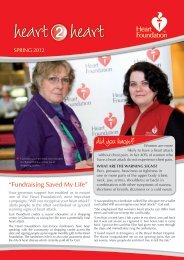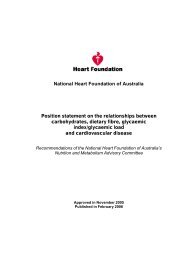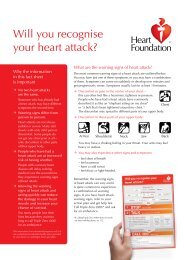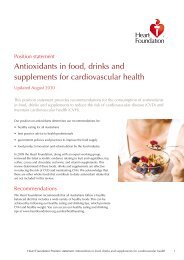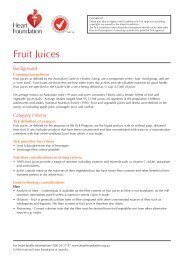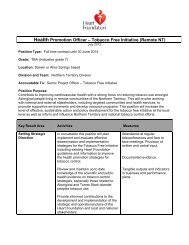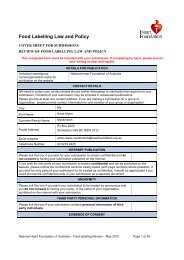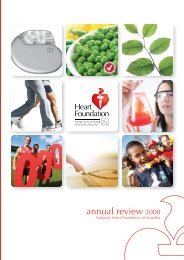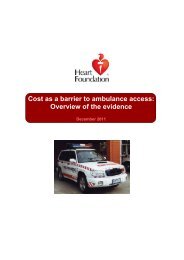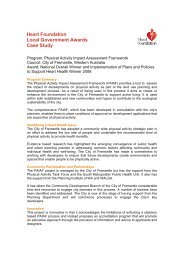Quality Use of Medicines for Cardiovascular Health - National Heart ...
Quality Use of Medicines for Cardiovascular Health - National Heart ...
Quality Use of Medicines for Cardiovascular Health - National Heart ...
Create successful ePaper yourself
Turn your PDF publications into a flip-book with our unique Google optimized e-Paper software.
Be<strong>for</strong>e a cardiovascular event (cont.)<br />
Be<strong>for</strong>e a cardiovascular event<br />
The bulk <strong>of</strong> cardiovascular risk assessment<br />
and prescribing is done in general practice.<br />
However, general practice is under significant<br />
pressure. A particular problem <strong>for</strong> GPs is the<br />
growing volume <strong>of</strong> clinical evidence and<br />
guidelines they are expected to know. The<br />
amount is far greater than they have to time<br />
read, and the volume too large to remember.<br />
GPs find keeping up to date difficult, especially<br />
when their patients have several conditions or<br />
are taking several medicines. The in<strong>for</strong>mation<br />
available to guide GPs is very fragmented<br />
and difficult to access as a whole. There is<br />
growing evidence that guidelines are not being<br />
translated into clinical practice.<br />
More effective ways need to be found to<br />
provide GPs with in<strong>for</strong>mation in ways that are<br />
manageable and memorable. Where effective<br />
methods have been found, they need to be<br />
more widely used.<br />
Counselling and education<br />
Some patients do not understand what their<br />
doctor tells them about cardiovascular disease or<br />
their treatment. Research has shown that patient<br />
confusion is responsible <strong>for</strong> nearly two-thirds<br />
<strong>of</strong> medicine-related problems after discharge<br />
from hospital. Research has also found that,<br />
while consumers are generally satisfied with<br />
their doctor’s technical knowledge, they felt that<br />
GPs’ greatest weakness is in communicating.<br />
The problem is not just a matter <strong>of</strong> doctors’<br />
skill, but also a lack <strong>of</strong> time to counsel patients,<br />
particularly when managing chronic diseases.<br />
Possible solutions include:<br />
• providing doctors with training on how to<br />
communicate with their patients<br />
• making greater use <strong>of</strong> nurses in general<br />
practice and hospitals to ‘interpret’ doctors’<br />
directions <strong>for</strong> patients and carers<br />
[ 6 ]<br />
Initiating medicines<br />
There is evidence that some doctors are underprescribing<br />
medicines which have been shown<br />
to be effective in reducing the risk <strong>of</strong> CVD.<br />
These include ACE inhibitors, beta-blockers and<br />
lipid-modifying drugs. Doctors would benefit<br />
from advice and training on:<br />
• the degree <strong>of</strong> current under-prescribing<br />
• risks posed by under-use <strong>of</strong> these medicines<br />
• appropriate use <strong>of</strong> these medicines<br />
• appropriate target doses<br />
Some <strong>of</strong> the common medicines used to reduce<br />
risk <strong>of</strong> cardiovascular disease can have side<br />
effects initially, and it may take doctors some<br />
time to find a <strong>for</strong>mulation or combination<br />
<strong>of</strong> medicines that is well-tolerated by the<br />
patient. This might involve switching between<br />
medicines, as well as titrating doses up and<br />
down. Many patients do not understand the<br />
reasons <strong>for</strong> these changes. Because <strong>of</strong> this, and<br />
the side effects, some patients refuse treatment.<br />
Some doctors need help explaining to<br />
consumers —be<strong>for</strong>e commencing a new<br />
medicine—why switching and changing doses<br />
is <strong>of</strong>ten necessary initially, and how long it may<br />
take to find a suitable medicine or combination<br />
<strong>of</strong> medicines.<br />
• greater counselling by pharmacists when<br />
dispensing medicines.<br />
Consumer medicine in<strong>for</strong>mation<br />
An important tool <strong>for</strong> educating consumers<br />
about their medicines is the Consumer<br />
Medicine In<strong>for</strong>mation (CMI) sheet. By law, all<br />
prescription and pharmacist-only medicines<br />
must have CMI. Topics that CMIs cover include:<br />
– the purpose <strong>of</strong> the medicine<br />
– issues to consider be<strong>for</strong>e taking the medicine<br />
– how to take the medicine correctly<br />
– what to do while taking the medicine<br />
– side effects<br />
– a description <strong>of</strong> the medicine.<br />
CMI is the only standardised consumer<br />
in<strong>for</strong>mation prepared <strong>for</strong> each individual<br />
medicine. They are normally provided<br />
by pharmacists at the time the medicine<br />
is dispensed.<br />
A 2004 review <strong>of</strong> pharmacies found that only<br />
12 per cent <strong>of</strong> consumers received a CMI when<br />
dispensed a prescription medicine. Also, many<br />
health pr<strong>of</strong>essionals, including nurses and<br />
specialist doctors, do not know that CMI exist.<br />
There is a widespread belief that consumers do<br />
not know to ask <strong>for</strong> CMI.



